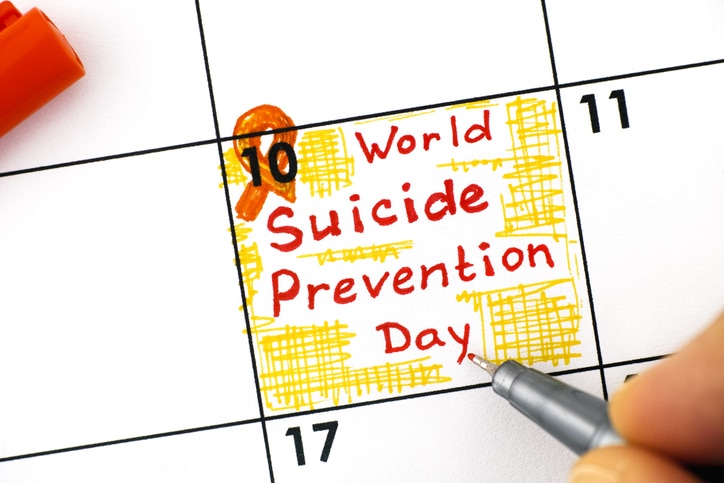By Anna McKenzie
In addition to being National Recovery Month, September is National Suicide Prevention Awareness Month. Globally, suicide accounts for 1.4% of all deaths, and most suicides are related to mental health issues. In the US, suicide ranks No. 10 among leading causes of death overall. Risk of suicide increases based on the severity of psychiatric conditions and other factors such as sexual orientation, gender, and ethnicity.
Mental Health and Suicide: Important Facts
Mental health and suicide are inextricably connected. It’s estimated that up to 90% of people who commit suicide have also suffered from mental health conditions. Some of these individuals may not have an official diagnosis, but there are usually indications that their state of mind is troubled. On our Beyond Theory podcast, we interviewed actress Gabriella Wright, whose sister Paulette committed suicide. Paulette was a musician, and Gabriella told us that her song lyrics revealed her mental and emotional struggle.
“When you look at her art… it’s like a jigsaw puzzle,” Gabriella says. “What she shared with the world was her lyrics … Everything was talking about how she was not feeling ‘in’ in the world. How she felt so much gap.”
Listen here:
This is one of the reasons why Suicide Prevention Awareness Month is so important. We need to remind ourselves and our communities to pay attention to the dangerous undercurrents of altered states of mind. Depression, anxiety, bipolar disorder, schizophrenia, trauma conditions, personality disorders, eating disorders, and substance use disorders can easily warp our view of ourselves and the world. The severity of these conditions can increase delusional, negative, and catastrophic thinking, increasing our risk of suicidal thoughts and actions. For every suicide, there are 40 attempted suicides.
Depression, whether on its own or developed from another condition, is implicated in 60% of suicides. Alcohol and drugs may often be used to self-medicate symptoms of depression. Alcohol, being a depressant, can further impair our mental state and ability to cope. According to one study, 68% of men and 29% of women who committed suicide were abusing alcohol or alcohol dependent.
It’s estimated that up to 90% of people who commit suicide have also suffered from mental health conditions.
Suicide Risk Factors: What You Should Know
Suicide is caused by a number of factors. Genetic makeup, environmental influences, and personality traits may all contribute to a person’s suicide risk. Outside of mental health issues, a handful of circumstances may predispose some individuals to suicidal thoughts or actions. Below are some examples of these, courtesy of the National Alliance on Mental Illness (NAMI):
- Young people who belong to the LGBTQ+ community are four times more at risk of suicide than others; transgender individuals are 12 times more at risk.
- Approximately 78% of suicides are men, who are more likely to complete suicide, even though women are more likely to attempt suicide.
- Native Americans, Alaska Natives, and non-Hispanic whites have higher suicide rates than other ethnic groups.
- Suicide is the second leading cause of death for individuals aged 10-34.
If you are concerned that a loved one is at risk of suicide, watch for the following suicide risk factors:
- Extreme mood swings
- Intense anger, sadness, or anxiety
- Insomnia or excessive sleeping
- Talking about dying, ways to die, or being gone
- Drug or alcohol abuse
- Expressing feelings of hopelessness, apathy, or emptiness
- Increase of risk-taking behaviors
If you or someone you know is suicidal, call the National Suicide Prevention Lifeline for immediate assistance.

How You Can Participate in Suicide Prevention Awareness Month
This year, National Suicide Prevention Week is September 5-11, and September 10 is World Suicide Prevention Day. We mark these days so that all of us can be educated and informed about the risk of suicide and help those who are struggling to receive the care they need. If you would like to participate during these days — or throughout the month — here are a few ways you can help:
- Educate your family, friends, and neighbors about mental health symptoms, suicide risk factors, and suicide warning signs.
- Check on loved ones who may be struggling and ask how you can help. If your friend or family member is displaying symptoms of a severe condition, enlist the help of a professional counselor.
- Post on social media about Suicide Prevention Awareness Month and encourage others to learn more or to reach out if they are hurting.
According to the World Health Organization, a suicide occurs every 40 seconds. Suicide is preventable, and it has already taken far too many lives. Together, we can spread the word about mental health and suicide and pave a path for those who are struggling to receive help and support.
Suicide is the second leading cause of death for individuals aged 10-34.
Substance Abuse and Mental Health Treatment at The Meadows
If you or someone you love is in need of treatment for substance abuse and mental health conditions, please contact our team today. We provide evidence-based treatment for whole-person healing at our family of facilities across the country. Our innovative, research-backed approach is focused on restoring the mind, body, and spirit for sustainable, long-term recovery. Get in touch with us today to learn more.



